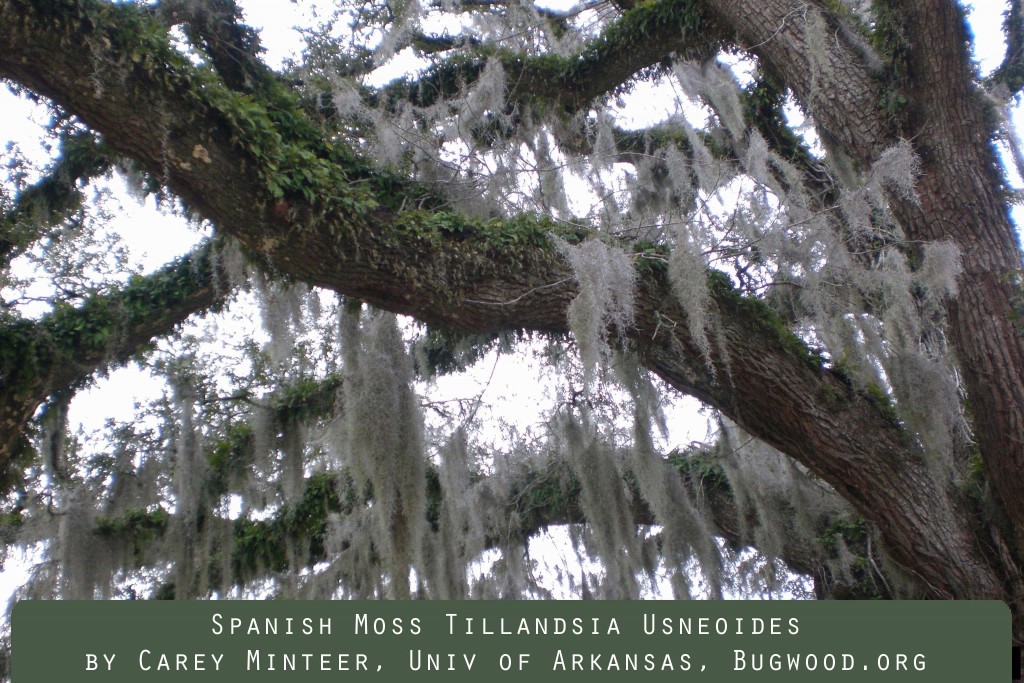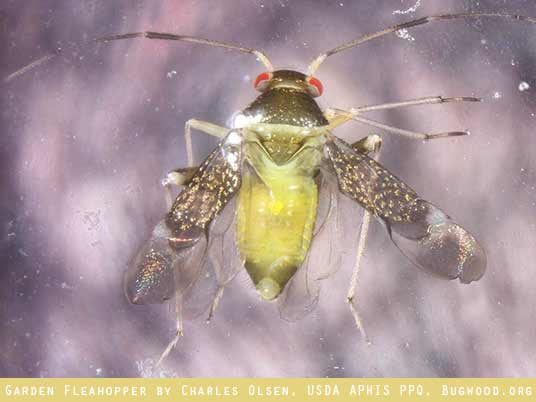
California Pest Rating for
Graminorthezia tillandsiae (Morrison): Spanish Moss Orthezia
Hemiptera: Ortheziidae
Pest Rating: C
PEST RATING PROFILE
Initiating Event:
On August 1, 2016 Dr. Natalia von Ellenrieder identified a sample submitted by a resident of Santa Ana (Orange County) as Graminorthezia tillandsiae, Spanish moss orthezia. A pest rating proposal is required to determine a permanent pest rating for this insect.
History & Status:
Background: Graminorthezia tillandsiae is an ensign scale insect that feeds on Spanish moss (Tillandsia usneoides) and small ballmoss (Tillandsia recurvata)1. It can be transported long distances when infested plants are moved.
Worldwide Distribution: Graminorthezia tillandsiae is native to Florida1. It has been found in Georgia, Louisiana, Virginia, Guatemala, and Germany1.
Official Control: Graminorthezia tillandsiae is not known to be under official control in any states or nations.
California Distribution: Graminorthezia tillandsiae has never been found in the environment of California except for one sample submitted by a resident of Santa Ana (Orange County).
California Interceptions: Graminorthezia tillandsiae was intercepted at nurseries in Orange County in 1993 and Ventura County in 1998.
The risk Graminorthezia tillandsiae (Spanish moss orthezia) would pose to California is evaluated below.
Consequences of Introduction:
1) Climate/Host Interaction: Spanish moss and small ballmoss only grow as epiphytes under very humid conditions. Graminorthezia tillandsiae only feeds on these hosts and is expected to establish in very limited circumstances in California. It receives a Low (1) in this category.
Evaluate if the pest would have suitable hosts and climate to establish in California. Score:
– Low (1) Not likely to establish in California; or likely to establish in very limited areas.
– Medium (2) may be able to establish in a larger but limited part of California.
– High (3) likely to establish a widespread distribution in California.
2) Known Pest Host Range: Graminorthezia tillandsiae only feeds on two species of plants in one family. It receives a Low (1) in this category.
Evaluate the host range of the pest. Score:
– Low (1) has a very limited host range.
– Medium (2) has a moderate host range.
– High (3) has a wide host range.
3) Pest Dispersal Potential: The biology of Graminorthezia tillandsiae is not well documented. It is assumed to have a high reproductive rate. It can rapidly spread long distances when infested plants are moved and receives a High (3) in this category.
Evaluate the natural and artificial dispersal potential of the pest. Score:
– Low (1) does not have high reproductive or dispersal potential.
– Medium (2) has either high reproductive or dispersal potential.
– High (3) has both high reproduction and dispersal potential.
4) Economic Impact: If Graminorthezia tillandsiae were to establish in California it is not expected to lower any crop yields. It could lower the value of Spanish moss and small ballmoss plants in the nursery industry by disfiguring them with its presence. It is not expected to disrupt markets, change cultural practices, vector other organisms, injure animals, or disrupt water supplies. Spanish moss orthezia receives a Low (1) in this category.
Evaluate the economic impact of the pest to California using the criteria below. Score:
A. The pest could lower crop yield.
B. The pest could lower crop value (includes increasing crop production costs).
C. The pest could trigger the loss of markets (includes quarantines).
D. The pest could negatively change normal cultural practices.
E. The pest can vector, or is vectored, by another pestiferous organism.
F. The organism is injurious or poisonous to agriculturally important animals.
G. The organism can interfere with the delivery or supply of water for agricultural uses.
– Low (1) causes 0 or 1 of these impacts.
– Medium (2) causes 2 of these impacts.
– High (3) causes 3 or more of these impacts.
5) Environmental Impact: If Graminorthezia tillandsiae were to establish in California it is not expected to lower biodiversity, disrupt natural communities, or change ecosystem processes. It is not expected to affect threatened or endangered species or critical habitats. It could trigger new treatment programs in the nursery industry and by residents who find infested plants unsightly. It is not likely to significantly impact cultural practices, home/urban gardens, or ornamental plantings. Graminorthezia tillandsiae receives a Medium (2) in this category.
Evaluate the environmental impact of the pest on California using the criteria below.
A. The pest could have a significant environmental impact such as lowering biodiversity, disrupting natural communities, or changing ecosystem processes.
B. The pest could directly affect threatened or endangered species.
C. The pest could impact threatened or endangered species by disrupting critical habitats.
D. The pest could trigger additional official or private treatment programs.
E. The pest significantly impacts cultural practices, home/urban gardening or ornamental plantings.
Score the pest for Environmental Impact. Score:
– Low (1) causes none of the above to occur.
– Medium (2) causes one of the above to occur.
– High (3) causes two or more of the above to occur.
Consequences of Introduction to California for Graminorthezia tillandsiae (Spanish Moss Orthezia): Low (8)
Add up the total score and include it here.
–Low = 5-8 points
–Medium = 9-12 points
–High = 13-15 points
6) Post Entry Distribution and Survey Information: There have not been any official collections of Graminorthezia tillandsiae in California. It receives a not established (0) in this category.
Evaluate the known distribution in California. Only official records identified by a taxonomic expert and supported by voucher specimens deposited in natural history collections should be considered. Pest incursions that have been eradicated, are under eradication, or have been delimited with no further detections should not be included.
–Not established (0) Pest never detected in California, or known only from incursions.
–Low (-1) Pest has a localized distribution in California, or is established in one suitable climate/host area (region).
–Medium (-2) Pest is widespread in California but not fully established in the endangered area, or pest established in two contiguous suitable climate/host areas.
–High (-3) Pest has fully established in the endangered area, or pest is reported in more than two contiguous or non-contiguous suitable climate/host areas.
Final Score:
The final score is the consequences of introduction score minus the post entry distribution and survey information score: Low (8)
Uncertainty:
There have not been any surveys of residential gardens for Graminorthezia tillandsiae. It might be more widespread.
Conclusion and Rating Justification:
Graminorthezia tillandsiae is only expected to establish in the warmest and most humid areas of California where Spanish moss and small ballmoss plants are cultivated. Its economic and environmental impacts are expected to be limited to nurseries and residents with these ornamental plants. A “C” rating is appropriate.
References:
1 García Morales M, Denno BD, Miller DR, Miller GL, Ben-Dov Y, Hardy NB. 2016. ScaleNet: A literature-based model of scale insect biology and systematics. Database. doi: 10.1093/database/bav118. http://scalenet.info. http://scalenet.info/catalogue/Graminorthezia%20tillandsiae/
Responsible Party:
Jason Leathers, 1220 N Street, Sacramento, CA, 95814, (916) 654-1211, plant.health[@]cdfa.ca.gov.
Pest Rating: C
Posted by ls





